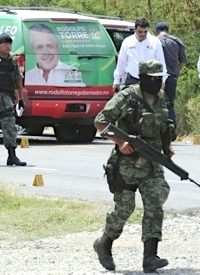
Seventy-two people, believed to be migrants heading for Texas were gunned down in San Fernando in the Mexican state of Tamaulipas, near the Gulf of Mexico and about 150 miles from Monterrey. Randal Archibold wrote in the New York Times for August 25 that the bodies were found the previous day in a large room on a ranch in northeast Mexico.
The lone survivor, an Ecuadorian traveling with people from Ecuador, Brazil, Honduras, and El Salvador, told investigators they had entered Mexico from the south when confronted by gunmen identifying themselves as Zetas about 100 miles south of Brownsville, Texas. Started by former Mexican army special forces soldiers, Zetas are known to extort money from migrants who pass through its territory.
In a related AP article on August 26, Eduardo Castillo wrote that authorities and diplomats working under heavy security began the gruesome task that day of identifying the victims. Refrigerated boxes were being readied to store the bodies from what could be Mexico’s biggest drug-gang massacre. Marines guarded the building holding the bodies, using vehicles to block access several streets away. The Mexican government flew diplomats from Brazil, Ecuador, and El Salvador directly to San Fernando to help identification. Brazil’s consul general in Mexico has said documents found at the scene indicate at least four of the dead were Brazilian.
On August 24, Ecuadorian Luis Freddy Lala Pomavilla staggered to a military checkpoint with a bullet wound in his neck. He told Mexican marines he’d just escaped from gunmen at a ranch in San Fernando.
The military units reached the ranch and engaged in a firefight in which one marine and three suspects were killed.
Then the marines discovered a horrific scene: Piles of people, some blindfolded, with hands tied behind their back, slumped on top of each other along cinderblock walls at the ranch. Fifty-eight men and 14 women had been killed. It was unclear how long they’d been dead or detained, or if they’d all been shot at once. The marines seized 21 assault rifles, shotguns and rifles, and detained a minor, apparently part of the gang.
Officials said several people were killed in short order after the migrants refused to pay or cooperate with the gunmen.
In a statement to police, Lala said leaders of the armed group had tried to extort fees from them and, when the migrants resisted, ordered gunmen to open fire. The Zetas are a drug gang whose control of parts of Tamaulipas is so brutal that even many Mexicans avoid traveling its highways.
If confirmed as a cartel kidnapping, the massacre could be the most extreme case so far and the bloodiest massacre of Mexico’s drug war.
Lala’s family told Teleamazonas — Ecuador television — on August 26 that he’d left his remote town in the Andes two months ago heading for the U.S. “I told him not to go but he went,” said one of his brothers. Lala’s parents already live in the U.S. and send money home to the family. He’d been the primary caretaker for his eight siblings and grandmother.
Lala’s wife in Ecuador told Teleamazonas her husband had paid $15,000 to the smuggler who was supposed to guide him to the U.S. That smuggler apparently tried to hide Lala’s fate from his family, calling on the 25th to say that he’d safely reached Los Angeles. It was the day after Mexican marines acting on Lala’s tip raided the ranch and found the victims. Drug gangs in Mexico often force human smugglers to abandon their migrants.
Alejandro Poiré, government spokesman for security issues, said that though the investigation was just beginning, the killings seemed to be an outgrowth of pressure on drug gangs by a government crackdown. “This act confirms that criminal organizations are looking to kidnapping and extortion because they are going through a difficult time obtaining resources and recruiting people willingly,” Poiré told reporters in Mexico City.
U.S. law enforcement officials have warned that drug trafficking groups have increasingly moved into the lucrative business of human smuggling, extorting fees from migrants for safe passage across the border and sometimes forcing them to carry bundles of drugs. Smugglers are known to rob, kidnap and sometimes kill migrants on both sides of the border.
This marks the third time this year that Mexican authorities have discovered large masses of corpses since the crackdown began in late 2006, this discovery being the largest. In May, 55 bodies were pulled from an abandoned mine south of Mexico City, and in July, 51 were discovered in a field near Monterrey, an industrial and commercial hub that had been relatively quiet until this year. In the other two cases, investigators believe the bodies were dumped at the sites over a long time. The cases were attributed to drug violence.
Violence has surged in northeast Mexico. Mayor Edelmiro Cavazos’ (see TNA: Police Arrested in Slaying of Mexico Mayor) murder last week near Monterrey coincided with a shootout outside Monterrey’s American School Foundation, a private school popular with American expatriates and Mexican business executives, prompting the U.S. Consulate to advise families to keep children home pending an assessment of security at the school.
In a meeting with mayors on August 25, President Felipe Calderon said, “We’re in the middle of a criminal spiral that we have to cut. I don’t know of any crime that isn’t organized. They are all very organized, and much more than the police.”
Migrants running the gauntlet through Mexico to the U.S. have long faced extortion, violence, and theft. But reports have grown of mass migrant kidnappings, forcing them to give telephone numbers of relatives in the U.S. or back home who are then required to transfer ransom payments to the abductors. The Rev. Alejandro Solalinde, who runs a shelter in the state of Oaxaca, where many migrants pass on their way to Tamaulipas, said Zetas have put informants inside shelters to find out which migrants have U.S. relatives — the most lucrative targets for kidnap-extortion schemes.
He constantly hears horror stories, including people who “say their companions have been killed with baseball bats in front of the others.” Solalinde said he’s been threatened by Zetas demanding access to his shelters, and he’s been told, “If we kill you, they’ll close the shelter and we’ll have to look all over for the migrants.”
Teresa Delagadillo, who works at the Casa San Juan Diego shelter in Matamoros just across from Brownsville, said she often hears stories about criminal gangs kidnapping and beating migrants to demand money — but never one on the scale of this week’s massacre. “There hadn’t been reports that they had killed them,” she said.
In an April report, Amnesty International said every year an untold number of migrants disappear without a trace. Mexico’s government has confirmed at least seven cases of cartels kidnapping groups of migrants so far this year, said Antonio Diaz, of the National Migration Institute, a think tank that studies immigration.
Other groups say migrant kidnappings are much more rampant. The National Human Rights Commission said 1,600 migrants are kidnapped each month. Figures are based on the number of reports received between September 2008 and February 2009.
Violence along the northeastern border with the U.S. has soared this year since the Zetas broke with the Gulf cartel. Authorities say the Gulf cartel has joined forces with its once-bitter enemies, the Sinaloa and La Familia gangs, to destroy the Zetas, who have grown so powerful they now reach into Central America.
Kidnappings and attacks on government security patrols are rampant in the highways surrounding San Fernando, where armed men claiming to be Zetas roam freely and the police station is pockmarked with bullet holes.
The region is at the end of a traditional migration route for Central and South Americans who travel up the Gulf coast to Texas. But migrants and immigration activists say they’ve never heard of an atrocity like this. Some have decided the journey has finally become too dangerous.
Almost 20 migrants staying at the Casa del Migrante shelter outside Mexico City turned home after hearing of the killings, said shelter worker Hector Lopez, a Nicaraguan who abandoned his own journey three months ago.
“I wanted to go reach the U.S. but when I saw what the situation was, what was happening to other migrants, I realized things could get worse for me,” he said.
But others refused to turn back, even though stunned by the news.
Wilber Cuellar, a Belizian migrant staying at the shelter said he’s been deported six times from the U.S. and once from Canada, but vowed the massacre would not deter him.
“I’m not afraid. I’m prepared to die,” he said. “I’m tired of suffering in this world.”
Border violence, however, doesn’t recognize the border. It spills into Texas and other border states, yet people will still do anything to come here. The U.S. is worth protecting by demanding that the border be sealed.
Photo: Earlier violence — Army soldiers guard crime scene after Rodolfo Torre, the candidate for governor of the state of Tamaulipas, was ambushed by unidentified gunmen near the city of Ciudad Victoria, Mexico, June 28, 2010: AP Images



